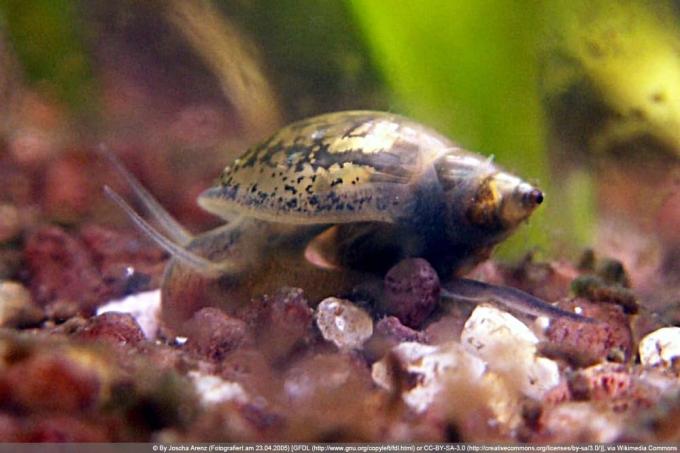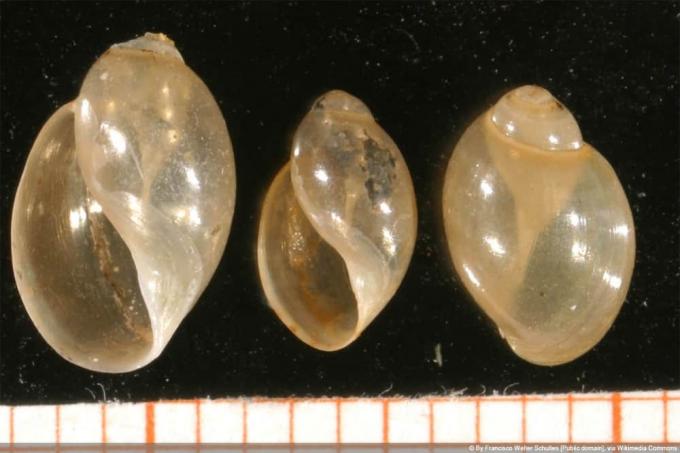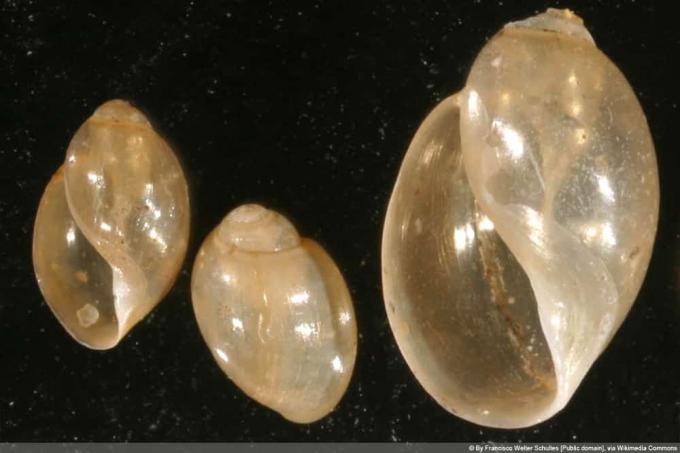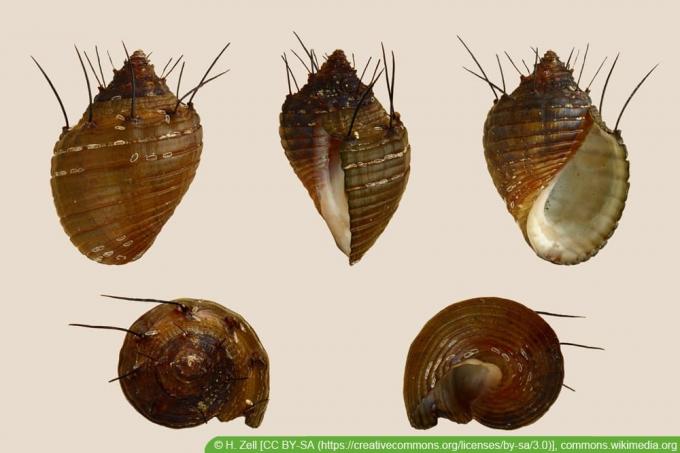

Table of contents
- Bubble snail in detail
- Caution: risk of confusion!
- attitude
- water quality
- Nourishment
- hibernate
- predators
- propagation
A well-functioning standing body of water in your own garden not only requires plants, fish or Crustaceans and the necessary technology, but also organisms that take care of the pond take care of. These include the bladder snails (Physidae), which are among the gluttons among pond cleaners and have been used for aquariums for a long time for this reason. They feed on dead plant debris of all kinds.
Bubble snail in detail
Bladder snails are snails that act as cleaners in aquariums and garden ponds due to their large appetites. They are small mollusks that usually don't get bigger than one centimeter, but can also reach sizes of up to 2.5 centimetres, which is extremely rare. They can be recognized by the following characteristics:
- Shell: turned to the left, smooth, mostly shiny, golden-brown coloration with black pattern, rarely transparent
- narrow foot
- moves very quickly in the water
- Pulmonary snail: does not have gills, but a breathing hole in the mantle cavity, part of the shell
- form visible slimy threads in a horizontal direction when moving in the water
- hermaphrodite
Due to their speed, they are thorough and effective in their task as aquarium cleaners and algae killers in standing water. It is often introduced via plants that are either placed in the garden pond or the aquarium or specimens that are used to green the bank area. These often contain the microscopically small eggs from which the snails hatch and do their work.
Tip:
If you want to use the bladder snails as a natural cleaning force for your garden water, you can find them in pet shops or in appropriate shops on the Internet. There they are usually offered in bags as feed for fish or crustaceans.
Caution: risk of confusion!
When purchasing the bladder snail, be careful not to accidentally buy the pointed mud snail (Lymnaea stagnalis). These are not peaceful snails that feed on plant remains, but living plants are on the menu. In addition, Lymnaea stagnalis strongly displaces the bladder snail, as it eats the living plants, which then no longer rot and are available as a food source for Physidae. You can recognize the snail by its shell. This rotates to the right, not to the left as in the bubble snail.
attitude

Bladder snails are extremely easy to keep, whether you keep them in the garden or in the aquarium. They actually take care of themselves completely and only need sufficient food and a suitable water temperature in order not to die. Due to their undemanding nature, however, they can also quickly become a nuisance, which is mainly due to the amount of food they have available. Still, it's a particularly beginner-friendly animal that you won't even notice in the garden pond unless you're looking for them.
water quality
When it comes to the water in the garden pond, the Physidae shines compared to other snails. The animals are indicator organisms of the third water quality class, which can survive and reproduce even in heavily polluted waters. Neither their health nor vigor nor reproduction is unaffected by poor water quality, making them excellent for still waters on your own property. Even if you have never cleaned your garden pond, the snails can live there. The water should still have certain values:
- Temperature: 5°C – 30°C, ideal is 15°C – 25°C
- pH of the water: 5.5 - 8.5
- Required amount of water: at least 5 l, ideally from 10 l
- Freshwater
In addition to the amount of water, the snails prefer a bottom made of fine sand or gravel with a medium grain size. There they can easily hold on when you eat. Otherwise they move floating or floating on the surface. Make sure that the temperature of the water never exceeds 30°C, otherwise there will be a real mass death of the animals. For this reason, you must be careful that your garden pond is not left in the blazing sun for several hours, otherwise the water could heat up too much. Below 5°C, the animals slowly go into their cold torpor, which is not fatal in the colony.
Nourishment
Nutrition is the most important point when keeping bladder snails, and many mistakes can be made here that either harm your pond plants or the snails. In contrast to other snails or insects, they have extremely weak chewing tools and for this reason do not eat living plants. So your plants are safe once you provide the bladder snails with the following feeds:
- algae
- organic remains of other living beings
- Leftover food from fish or crustaceans
- decaying plant debris
- tofu
- flake food
- typical food tablets

A big advantage of the animals is their tolerance to a change in diet. For example, if you can no longer find plant remains, they switch completely to algae nutrition, if these are available. This is also the reason why the small mollusks are so popular with aquarium owners. They eat algae at a fast rate and can thus free the pond from massive accumulations of algae even in hot summer. In doing so, they improve:
- water quality
- quality of life for other pond inhabitants
- pond temperature
Algae is one of the main foods for snails and as any pond owner knows, algae build-up is often a problem. The animals don't even care about the quality of the food. They simply eat everything that comes their way and live peacefully with other snails or animals as long as they do not feed on the snails. However, be aware that if there is insufficient food available, other sources will be used, i.e. your pond plants. These are consumed as emergency rations, even if the little animals need a very long time to do so.
Tip:
If there is little algae formation in the garden pond, provide additional plants in the pond or choose one of the feeding methods mentioned above so that the animals do not die in large numbers. For example, you can shred tofu and throw it in the pond or use classic plant-based flake food for fish.
hibernate
The bladder snail can easily overwinter in the garden pond as long as you don't empty it during the cold season. It is important that you do not only have individual snails, as they can only survive the winter together in a larger group.
predators
Due to its size, the bladder snail does not have it easy in a well populated pond. It is eaten by all pond inhabitants that are larger than the snail. She has no defense mechanisms other than her speed and armor, which can be cracked very easily. Larger fish in particular feast on the tasty snails and can eradicate their population within a short time. For this reason, they are often used as live food. Once the snails are able to reproduce without problems, they provide a never-ending food source for pond fish.
propagation
Propagating bladder snails is as easy as general care, but there are a few things you need to be aware of to keep the population from getting out of control. Because the animals are hermaphrodites, it doesn't matter if you're only have female or male specimens in the pond, this is later determined by the snails themselves adjusted. The following properties must be present for propagation:
- Water temperature: 20°C at least, the higher the more effective, but not over 30°C
- live aquatic plants to attach the eggs to

Aquatic plants are essential for bladder snails. Without these, they cannot multiply and after a while your pond will be free of the snails again. They have an average life expectancy of four to six months and as soon as there are not enough plants available for laying eggs, the population stagnates extremely. Therefore, you should not only have dead plant remains or algae in the pond. Even one plant is enough here. The propagation happens as follows:
- Despite the hermaphrodite two animals are needed. These change their gender according to necessity.
- After fertilization, the female changes sex and, as a male, lays five to 50 eggs as a clutch on the plants.
- The eggs mature for about a week until the hatchlings are fully developed.
- Sexual maturity develops over about four to five weeks, depending on the warmth of the water.
- After that, the animals can multiply again and maintain the population.
Tip:
If the snails continue to multiply at a rapid rate without stopping, there is a reason for this. If the bladder snails become a real nuisance, the fish or crustaceans in the pond are fed too often and the excess food causes the animals to reproduce too quickly.
 garden editorial
garden editorial I write about everything that interests me in my garden.
Learn more about pond animals

Marsh snail in the pond | 9 Posture Tips
Of the nearly 100,000 species of snails, only about 40 live in freshwater. The mud snail is one of the ten species that can also be found in a pond. It inhabits the bottom of the body of water and contributes significantly to cleaning it there.

Swimming pond with fish: This is how the combination works
A swimming pond with fish can be a very special highlight in the garden. However, the fish pose special challenges because the nutrient content of the water is significantly increased. However, the combination is possible with an appropriate structure and comprehensive filtering.

Tower snails | 13 tips for keeping & propagation
Tower snails are particularly popular aquatic animals in garden ponds - at least as long as they don't multiply endlessly. They also signal in aquaria whether optimal conditions exist. Tips for husbandry and propagation create an improved habitat without mass propagation.

Keeping pond mussels in the garden pond | 9 Posture Tips
The trend towards natural garden ponds has been unbroken for years. Many garden owners use it to create their own small wet biotope. However, this is not possible without appropriate stocking with plants, small fish and pond mussels.

Dragonfly larvae in the pond: what do dragonflies eat?
Anyone who finds dragonfly larvae in the pond can be happy. Because the insects are useful predators and can, for example, reduce the number of mosquitoes. However, they do not feed exclusively on animals that can cause harm. Here's what dragonflies eat.

Keeping Sunfish in the Pond | 7 tips on husbandry & feed
Perch are predatory fish and therefore rather unsuitable for pond keeping. An exception, however, is the magnificent bluegill, which usually gets along well with other fish. Here is what you need to pay attention to when keeping it.
